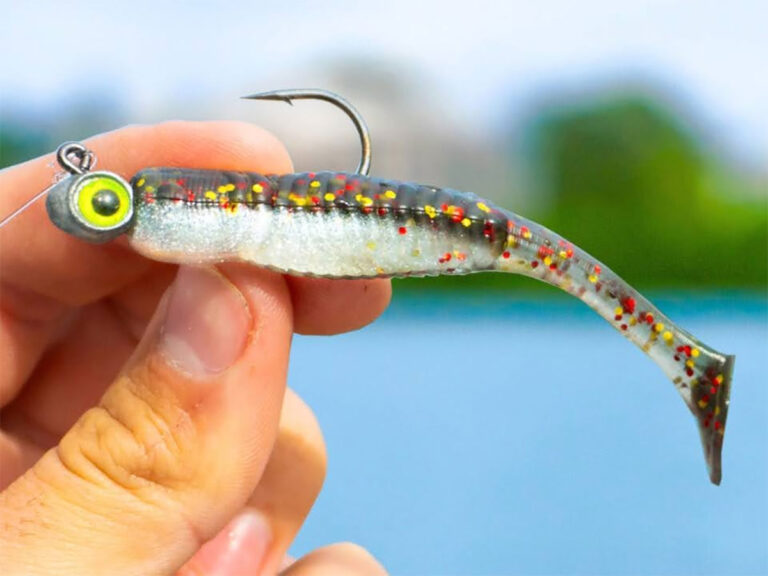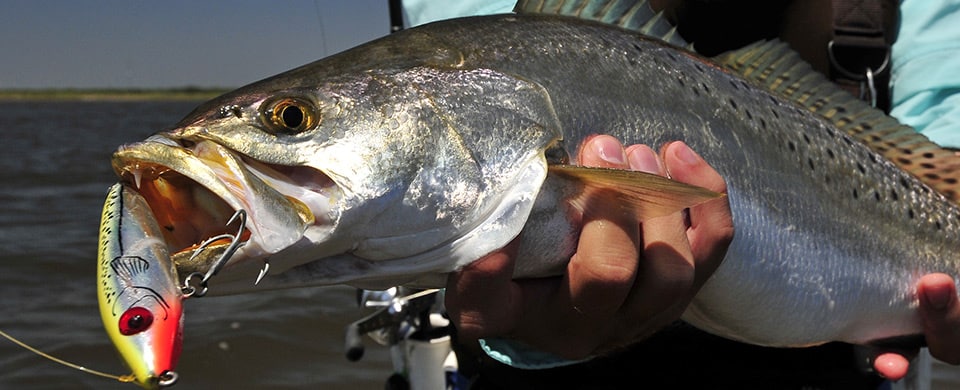
Gator Trout
I vividly recall my first speeding ticket. Back then, I thought if I waited as long as possible and presented it to my father at just the right moment, time and mood might make for less of an impact on my allowance. I adopted a similar strategy as my dad and I raced across the bay in a shotgun-start trophy-trout tournament. He looked increasingly uneasy as we zipped past several groups of gulls working over obvious seatrout schools. As I drove and he helplessly gripped the console handrail, my confession loomed.
“We are not fishing those birds – we’re going to fish a shoreline and search for redfish and hope for a couple of big trout with them,” I said. My father shook his head in disbelief while looking back at the surface-busting trout. This had better work, or I would have some serious explaining to do.
**A Set Scene
**Upon arrival at our destination, we noticed that a strong flood tide was pushing brilliant green water toward the shoreline while a gentle southeast breeze forced vast schools of large mullet to surge, struggle, and leap into and out of gentle breaking swells. Likewise, small schools of finger mullet and menhaden darted and ducked into and out of oyster grass, displaying a nervousness only big feeding fish can create. Remember that redfish generally position themselves upstream and downstream from the mouths of cuts where waters empty into larger areas, such as lakes and lagoons. This particular shoreline proved ideal because it provided structure, water clarity and bait. Soon after our arrival, the water began retreating from the grassy edges, pulling a variety of crustaceans and baitfish into open water.
Lesson Learned
Just like the day I searched for words and stumbled over excuses after showing my dad that speeding ticket, I found myself grasping for words of encouragement and patience as we worked the area for 30 minutes without a bite. As I began to question my sanity, a redfish exploded on my Mirr-Olure. I felt the boat shudder a bit and, out of the corner of my eye, saw my father lean into a fish as well. Calm turned to chaos as the fish began
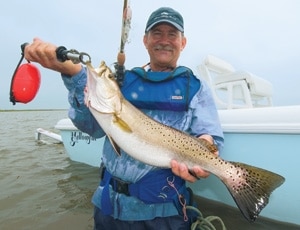
moving up and down that shoreline like speedy red vacuum cleaners – feeding voraciously on anything and everything in their path. Puffs of mud clouds grew from the bottom, and slicks started to appear periodically off in the distance. My father and I positioned ourselves on the front deck and intermittently took turns running the trolling motor and hooking fish. Once we established some confidence in the fish’s pattern, I began trying baits of increasing size in an attempt to persuade a trophy-size seatrout. I continued to throw various topwater lures and big crank baits while my father made long casts with B&L Corky and MirrOlure Catch 2000 lures. Although a soft-plastic suspended lure, the Corky held up well to the constant barrage of those deep bronze-backed bruisers. The trout we were seeking had to be somewhere in the midst of that feeding frenzy. Methodically, we worked that school, hopefully anticipating that the next thump or topwater explosion would be our tournament winner. I watched as my father quickly reared back on yet another strike. This fish was different; although it peeled a good deal of line off his reel, it stayed near the surface, making a series of surface kicks and rolls. Finally, after a few seconds, the fish came up, shaking its head in a furious attempt to rid its jaws of my father’s lure. Seatrout! My dad fought it admirably, then landed it and placed it carefully in our release well: a beautiful 7-pound trout that won the tournament for us that day.
Mission accomplished.
Next: Tactics in Depth>>
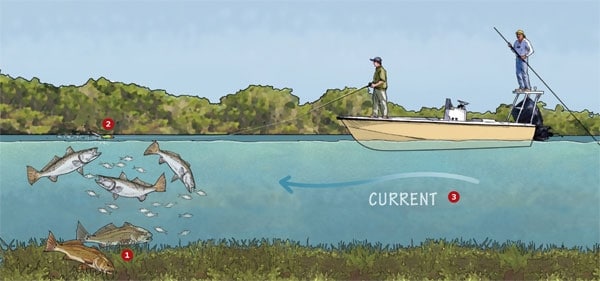
Joe Mahler / www.markerjockey.com
Over the Top
Capt. Steve Jones has been guiding clients on Florida Panhandle waters in and around Pensacola for nearly 30 years. Jones occasionally finds big trout lurking among redfish and agrees that trophy trout may take advantage of dining reds.
“Feeding redfish schools tend to nose bait up from the bottom (1),” says Jones. However, he has found that those reds generally stay lower in the water column, while the trout can be enticed readily with surface lures (2). “I like to throw topwaters, especially Storm’s Rattlin’ Chug Bug,” he says. “I like lures that make a commotion.” A stealthy and careful approach is critical, though. “I like to stop my boat at least 100 yards away (3) and use the wind and current to my advantage,” he says. “On calm days, I generally will use a push pole. If I have to use my trolling motor, I run it slow and intermittently.” Avoid common boat noises like bumps and squeaks of hatches, and keep your feet quiet when you cast. Catch-and-release is paramount to Jones, and he likes to customize his lures, swapping trebles for single hooks and beefing up his split rings. “Trebles catch well but have a propensity to hurt fish – the single hooks enable quick, safe releases,” he explains.
***
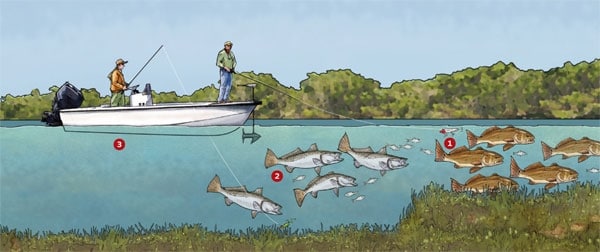
Joe Mahler / www.markerjockey.com
When redfish are on the move, plowing through schools of bait aggressively and quickly, look for trout – and often large trout – following at the rear of the school, picking off the scattered and confused baitfish.
Fishing up and down the coast of Texas, Capt. Ed Hix of Houston has had success in the TroutMasters tournament series, as well as in the FLW Redfish and Redfish Cup tours. “I have fished several big schools of redfish, specifically targeting trophy trout – when you find them together, it is possible to find trout up to 8 pounds,” Hix says. He has spent many years honing his big-trout skills in Texas’ pristine waters and believes that when schools of redfish are aggressively feeding, they will move quickly through areas (1) , gorging on and disrupting schools of baitfish. “I really believe that when seatrout hang with those reds, they are picking up the stragglers (2) – the spoils of war,” he says. Using his trolling motor and keeping his eyes peeled on mud boils, Hix will position his boat just behind a school – within casting range. “My trolling motor is crucial,” he says, “as I usually try to stay within casting distance of those fresh boils created by the redfish – many times trophy trout can be found right in and behind those. If I were primarily pursuing redfish, I would position my boat on the outskirts or up and ahead of the lead fish, but seeking to fool a really big trout, I will stay toward the back of the school (3) .” Perhaps a “good” problem is that anglers will have to catch and release a slew of redfish before seducing that one hefty yellow-mouth.
Next: Where and How>>
_
_
Because Capt. Ed Hix may have to wade through the redfish before tying into a trout, his bait choices favor durability over color or size. “Redfish tend to destroy soft-plastics,” he says, “while hard baits allow me to continue casting without stopping. These fish tend to be on the move, and the less downtime I have replacing lures, the better.” Aware of the redfish’s tackle-busting prowess, he prefers hard-plastic topwaters and suspended lures rather than soft-plastics.
Use lures such as ThunderSticks and Slap-Sticks, as well as chrome Mirr-Olure She Dogs. Rapala’s X-Raps will also survive the rigors of bruising redfish strikes. Keep multiple setups and fresh lures handy to maximize your time when chasing schools.
Rods: 7-foot medium-action spinning and baitcasting rods.
Reels: Sized to match rods.
Lines: 8- to 16-pound mono with 60-pound fluoro leaders.
Lures: ThunderSticks, Slap-Sticks, MirrOlure She Dogs, Rapala X-Raps, Storm Rattlin’ Chug Bugs, B&L Corkies and MirrOlure Catch 2000s.
***
Jerry Ferguson, a marine biologistfor the Louisiana Department of Wildlife and Fisheries, says: “Redfish generally begin to move offshore when they reach 4 years of age or 8 to 10 pounds. Prior to that, they feed on just about everything inshore, from crabs, menhaden and shrimp to mullet.” Regardless of the fact that seatrout and redfish are from the same family of drum, once trout reach a certain size, their eating habits begin to differ from redfish. “Once trout reach 4 pounds, their diets move more toward an all-fish diet of mullet and menhaden – they especially like mullet,” says Ferguson. “Schools of redfish will disrupt schools of mullet, creating a feeding advantage for trophy-trout anglers.” Both Ed Hix and Steve Jones agree that once a school has been located, anglers need to determine which species they’ve hooked and try to fight it accordingly. Hix explains: “Trophy trout and redfish strikes are similar, but trout tend to surface more readily, with shorter bursts, while redfish tend to make steady, protracted runs. Once you determine species, get redfish in quickly for release while backing off drags to carefully coax trophy-size specks into the release well.”
WHAT: Trophy seatrout.
WHEN: Under and around schoolsof redfish.
WHERE: Gulf Coast of Texas, Louisiana, Alabama and Florida.
WHO: The guides listed below specialize in finding large trout with redfish.
Texas and Louisiana:
Capt. Bruce Baugh
337-660-1814
Louisiana:
Capt. Guy Stansel
337-762-3391, 337-762-3791 (cell)
Florida and Alabama:
Capt. Steve Jones
850-457-4106, 850-380-4101 (cell)








